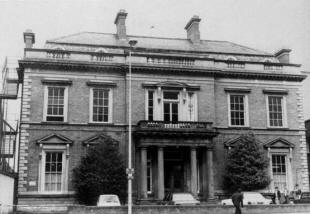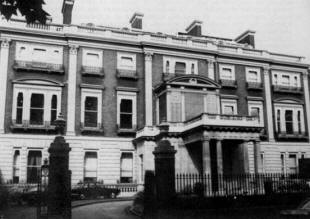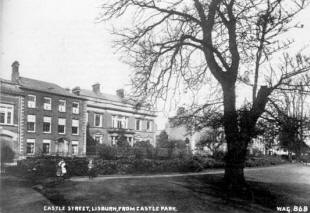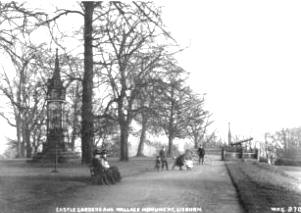
- Front Page
- Editorial
- Contents
- So many Proofs?
- The Wreck of the 'Draper'
- Wilmont, Dunmurry: A Profile
- A Portrait of Counsellor William Sampson
- Newspaper Miscellanea
- Lisburn House, Dunedin, New Zealand
- Barney McCann
- Book Reviews
- The oldest register of the parish of Derriaghy
- The heritage of Drumbo
- Once upon the Lagan by May Blair
- Historical Journals
So many Proofs?
Aspects of the legacy of Sir Richard Wallace in the fabric of Lisburn
By Hugh Dixon.
 |
 |
| Wallace House , Castle St, 1981 (Copyright Northern Ireland Archaeological Survey) | Hertford House, Manchester Square, London, 1980 (Copyright H. Dixon) |
The historian works largely with paper, with letters, documents, records, books or broadsides, and, only occasionally resorts to inscriptions on more durable materials. The building historian, professional or amateur, enjoys an added resource for study, in buildings, structures of all kinds, and the spaces between them, and in the planting, paving and paraphernalia which adorn them - or otherwise. As the scholar leans into his book, so the building historian, oblivious of puddles, prams, traffic or time, devours buildings from foundations to chimneys, wondering who did this, when, for what reason, and at whose instructions. Every building is itself a document supplying information about people; there were those who designed and built, those who inhabited it, and the patron who supplied the money. Standing in Lisburn eighty years ago, in any of the main spaces, a visitor could not help being aware of the town's late landlord and principal patron. Luckily those visitors included a number of distinguished photographers l, because today it is not so easy to detect the generous influence of Sir Richard Wallace, Baronet, heir to the Irish estates of the Marquesses of Hertford.
Wallace's career has received recent and majestic treatment in this journal 2, and it is here only necessary to rehearse those facts which have a bearing on his building and planning activity in Lisburn. The rapturous welcome he received on his first visit to the town in 1873, together with being returned unopposed as its Member of Parliament the following year, deeply impressed him. He probably formed even at a distance a genuine fondness for the people of the borough, and certainly seems to have taken his duties as M. P. seriously. Nevertheless, as one used to rather more sophisticated architecture in Paris and London, he must have found the buildings of Lisburn quaint rather than exhilarating. He never seems to have seriously considered living in the town, at least not for more than a few days each year, and yet he did take many steps towards enhancing its architecture. Mr. J. F. Burns may well be right in identifying in Sir Richard's actions the desire to establish a more permanent contact with his Irish estates through the residence there of his son, Edmond3.
If this was his intention, it was thwarted by their estrangement, and then Edmond's early death in 1887. Much had been achieved, however, before this unhappy outcome turned Sir Richard's enthusiasm to despair.
At first he must have been absorbed with organising his new English properties, especially with remodelling Hertford House in London, and installing his great art collection. But Lisburn was not neglected; for decades before Wallace's arrival the directories had pronounced it 'one of the handsomest and cleanest towns in Ireland'4. but by 1877 they could add: 'The vast increased improvements which have taken place ..... are unprecedented in the history of any town in Ireland, chiefly caused by the leases in perpetuity, at moderate rents, that have been granted to residents and non-residents, who have erected several handsome villas (which are taken as soon as finished), and as many as 200 workers' houses of a superior class, which are much required, as previously the mill-workers were huddled up in filthy and miserable hovels, free of all decency and respect to morality' 5, To what extent the new policies were influenced by the enlightened attitudes of Wallace himself, or his new agents, Frederick and Claude Capron, remains a matter for study. Lisburn was growing (from 7,484 in 1861 to 11,000 in 1880, and 12,388 by the end of the century 6); houses were needed, but so were schools, and larger churches, and better communications, and buildings for administration, commerce and entertainment. In all these departments Wallace played a part, either by giving sites, or by direct building works 7. What also emerges, no doubt enhanced by the rapid development of suburbs and consequent disappearance of open land near the town, is his concern to protect and enrich the remaining central spaces. The famous Wallace fountains appeared at three main road junctions, another one in the Castle Gardens, and a fifth in the large new park presented to the town by Wallace and still bearing his name 8.
 |
 |
| Wallace House and its neighbours, c1910 (?) (Copyright Ulster Folk and Transport Museum: WAG868) | Castle Gardens and the Wallace Monument c.1910(?) (Copyright Ulster Folk and Transport Museum: WAG870) |
The same concern for space marks Sir Richard's three main building projects, the remodelling of the Assembly Rooms, and the building of the Court House and Castle House. Each was designed to make an important contribution to its surroundings, and each did so. Their subsequent fates have been curiously varied.
The Assembly Rooms building, now gloriously restored to house the new Lisburn Museum, has revealed during the course of the works its origins as a seventeenth-century market house9. Its story, already the subject of the Museum's opening exhibition this year, is to be published in full 10. It is enough to note here that Wallace's handling of the Italianate exterior gave the building a full measure of three-dimensional strength which its important position undoubtedly merits.
Mention of the old Court House should bring the people of
Lisburn out in sackcloth, to weep in their thousands. Undoubtedly the most
architecturally satisfying of all Sir Richard's buildings, it was based on a
design by the great Italian architect, Andrea Palladio, and combined a full
vocabulary of classical features in a composition of stirring authority. Its
main portico and entrance faced west across the open space of the Railway
Station forecourt and on to Bachelor's Walk, while the angled view from the
Railway Street junction revealed a fine south elevation with tall arched
windows, and a surmounting triangular pediment enclosing the Wallace Arms and
motto 'Esperance'.
Hope, unfortunately, was not enough; the
building needed care and attention, like any work of art. It was demolished in
1971, and its dignified presence is sadly missed. 11
![]()
Sir Richard Wallace's most successful combination of building, planning and planting, however, was in Castle Street, for it was here that he undertook 'to redeem a promise made in 1845 by the Fourth Marquess to his tenantry .... to build a house in Lisburn'12. The original castle of Sir Fulke Conway begun in 1622 had been a great symmetrical manor house of brick and framework, facing westwards towards the church (now Cathedral) with projecting wings, and a grand classical entrance in a jutting central bay with canted sides l3. It was surrounded by a walled enclosure divided into several courts, with gardens outside to the south, a green (probably used for bowling) towards the church, and a vegetable garden beyond the powder house, brewhouse, and other outhouses to the north along the High Street (now Castle Street). The Castle may have been damaged or left unrepaired during the mid-century wars because 'rebuilding' was necessary afterwards, and Anne, wife of the 3rd Viscount Conway, gave advice l4, and thus emerges as Ulster's earliest recorded woman architect. Other works are known to have been carried out in the 1660's and 1670's by John parley, a mason, and another John Darley, a 'famous' carpenter l5; and it was at this time that the only surviving part, the east wall with its gateway16, was built. Constructed of red sandstone, the gateway has a semi-circular archway, and battlements with elaborately curved tops and a date panel '1677'.
The old castle was completely destroyed in the great town fire of 1707 and never rebuilt. The ground appears to have lain derelict for a long time but eventually it was decided by the landlord to turn it into a public park. This was certainly achieved in 183317, and possibly much earlier; some plantings from the original garden still survived: William McComb in his Guide to Belfast (1861)18 notes that there were 'a pair of remarkable elm trees, called "the Two Sisters", which were of the most gigantic growth. One of these yet flourishes; the other was all but destroyed by the great tempest of January, 1839'.
Wallace would have been well within his rights to return the garden, to their former privacy and to build his new house there. But he must have realised that this would be unpopular; the gardens, kept in fine order at the expense of successive Marquesses, were not only the boast of the town but a very necessary public open space. Wallace wished, nevertheless, to establish some connection between his new building and the old castle site, as if to imbue it with the authority of heredity. The solution was at hand; immediately across Castle Street from the gardens was a large Georgian house, called 'Marquis House' in 1833 19 which had a separate office block to its east, a large yard behind, and a long garden stretching down to meet that portion of the old outer demesne which had been cut off on the town side of the railway, and had not therefore become part of Wallace Park. What 'Marquis House' had been used for is not clear but it may have been occupied by Hertford agents or surveyors, who were soon occupying the house to the west (now the Police Station). Here then was a site which offered direct visual contact with the Castle Gardens in front, and access to a pocket-demesne at the rear. Now Wallace had to choose an architect; he had not far to go.
Thomas Benjamin Ambler (c 1838-1920), architect of Leeds, is principally remembered as a corporation valuer, and as a designer of rather risky moorish style warehouses 20. How he came to the notice of Wallace is not known; how he should have been chosen to remodel Hertford House in Manchester Square, London, to house the enormous art collection is an even greater mystery. As Wallace's London architect, however, it is hardly surprising to find him providing a chip off the main block, a design for Castle House. Whether he ever came to Lisburn seems doubtful. The building of the house was conducted, as the Court House had been, by Wallace's local surveyor and engineer, John MacHenry, who may well have designed some of the details 2l.
Hertford House and Castle House - or Wallace House as it is now known (fig. A) have much in common, and a brief comparison is justified if only to counter the repeated rumour, firmly held in some Lisburn quarters, that they are 'the exact same'. Hertford House 22 is not only larger, (fig. B), it is enormous by comparison, having three full storeys plus attics, being a triple bay wider (a large room extra) on each side of the facade, and extending back with a great series of galleries which enclose a courtyard into which Wallace House would fit quite neatly. In facade design on the other hand, Wallace House is much better behaved; its single-storey portico of four Tuscan Doric columns and other sober classical details including very old-fashioned, six-pane sashes in the windows, look pleasantly stable in comparison with their more fussy London counterparts.
The interior planning is also quite distinct. Hertford House was not totally built for Wallace but remodelled from a large house built for the Duke of Manchester a hundred years earlier. The front door leads straight to a great central double-return staircase. In Wallace House, the staircase, though large, occupies a side space, subordinate to a central galleried hall which was clearly designed for the display of large paintings and other works of art. This was to have been the most important space in the house, and the most important feature in a great axial composition. The old house was demolished so that the new could be set back from the street line (fig. C) thus using the neighbours as a frame, a favourite Victorian way of giving the central building importance 23. From the front gate a visitor would travel right along the axis, through the front garden, under the portico, and into a fine entrance hall. Here the excellent woodwork of the doors and classical details would be admired. More central double doors gave access to the great galleried hall, and beyond this to a central saloon with a curved bow window, through which the back garden could be viewed; and visited, because below the window a double-curved staircase led to an inner formal garden with seven flights of step;, and beyond to the wider parkland with its great ranges of glasshouses 24. It all could have been so grand .......
Indeed, it was grand, and almost entirely unused until 1914 when it became the nucleus of the Technical School. Gradually the back park has been covered by Wallace Avenue and its subsidiary streets; the back garden is now beneath a collection of buildings and wirescapes which render to utility more than they do to beauty. Least forgivable of all was the decision taken in 1962, to remove the eastern framing block on Castle Street, and replace it on a different building-line with a structure which could scarcely be less sympathetic. But Sir Richard Wallace saw none of this, and, curiously enough, very little of his own work either. His last visit to Lisburn came in 1880 only seven years after the first 25. Wallace House was barely complete, and most of the other major projects not even started. Increasing worry about his son led first to disillusionment and then despair. He resigned his parliamentary seat in 1884, and lost interest in the art collection, eventually leaving his wife to sort out its bequest to the nation. Finally he became a recluse, dying, where for the greater part of his life he had lived, in Paris, in 1890. Two years later the people of Lisburn raised a modest version of the Albert Memorial (fig. D) in Castle Gardens 26:
'To perpetuate the memory of one whose delight was to do good, and in grateful recognition of his generous interest in the prosperity of this town of which it possesses to many proofs.
The proofs are now rarer than they were ninety years ago, and therefore more deserving of attention and care.
NOTES
| 1. | Particularly the anonymous photographer whose work illustrates F. Kee, Lisburn h1isce11any, 1976; and W. A. Green whose collection is now in the Ulster Folk and Transport Museum, at Cultra, Co. Down. |
| 2. | Volume 3, December, 1980. J. F. Burns, 'The Life and Work of Sir Richard Wallace, Bart., M. P.' pp.8-22. |
| 3. | Burns, op. cit., p.18 |
| 4. | From standard description used in Belfast Directories, 1852-1870. |
| 5. | Belfast Directory, 1877, p.701. |
| 6. | Figures from Belfast Directories |
| 7. | Burns, op cit., p.21. |
| 8. | see F. Kee, Lisburn Miscellany, 1976, pp.80-1, for contemporary description of the Parisian fountains; also Brett, C.L.B., and Lady Dunleath, List of Historic Buildings .... in Lisburn, 1969, p.10. |
| 9. | Brett and Dunleath, op.Ctcit., p.9; and Brett, C.E.B., Court Houses and Market Houses of Ulster, 1973, p.33. |
| 10. | By the Curator, Mr. B. Mackey, to whom I am particularly grateful for the opportunity of seeing the restoration works in progress, and for much further information. |
| 11. | Brett and Dunleath, op.cit., p.9, and illustration p.4; and Brett, op.cit., p.34, and illustration p.35. The building is also illustrated in G. Gamblin, The Town in Ulster, 1951, plate 46. |
| 12. | Burns, op.cit., p.18. |
| 13. | Public Record Office of Northern Ireland (PRONI): T343/1 Copy of 'A Grount Plotte of Lisnagarvey', dated in catalogue 1632. |
| 14. | R. Loeber, A Biographical Dictionary of Irish Architects 1600-1720, London 1981, pp.6-7. |
| 15. | Loeber, op.cit., p.45. |
| 16. | There is a good illustration of the gateway, unblocked, in F. Kee Lisburn Miscellany, 1976, opp. p.26. |
| 17. | PRONE OS9/11/1/2: Ordnance Survey of 1833 drawn by J. Gamble. |
| 18. | W. McComb, McComb's Guide to Belfast, The Giant's Causeway, 1861 (reprinted 1970 , pp.89-90 |
| 19. | PRONI: D427/6: Estate Map of 1833 drawn by Thomas Pattison. |
| 20. | Obituary in The Builder, 23 Jan. 1920, p.104 |
| 21. | Brett, op.cit., pp. 33-34. |
| 22. | see The Wallace Collection (guide leaflet) or A General Guide to The Wallace Collection for plans and illustrations. |
| 23. | There is a good photograph showing the importance of this 'frame' in G. Gamblin, The Town in Ulster, 1951, plate 48; and others in the Green Collection, UTTM: WAG 868, 869, 874. |
| 24. | PRONI: OSB/17/3/5: Ordnance Survey of 1909 shows this full layout. |
| 25. | Burns, o .cit., p.19. |
| 26. | The monument, designed by Robinson and Son of Belfast (Irish Builder, 1892, p.117), forms a focus for the main path from Castle Street. It includes beneath the gothic canopy a bronze portrait relief of Sir Richard Wallace, in profile, looking perhaps a little wistfully towards the west. |
The author wishes to express his thanks to all who has
assisted with his wanderings about Lisburn, both on foot and on paper, and
especially Mr. H.G. Bass; Mr. R. Kirk; Mr. J.H. MacDowell, Principal of the
Technical School; Mr. B. Mackey; Mr. and Mrs. F. Rankin; and Mr. T. Neill, ever
helpful and patient Editor of this Journal.
